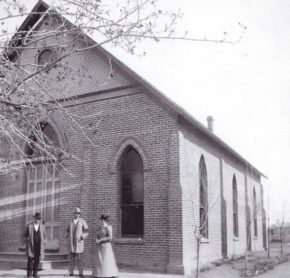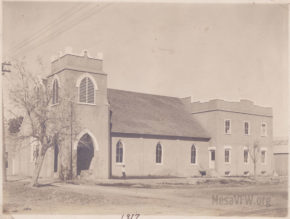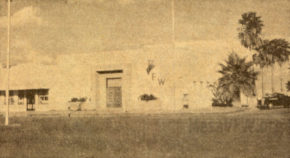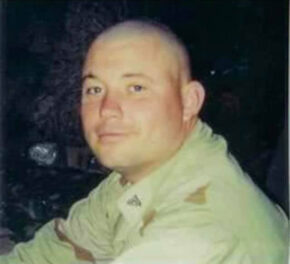65 S MacDonald
Post 1760 Building History

VFW Post 1760 hall has been at its current location for more than 65 years with a notable building history. But before Post 1760 took ownership of the property it was owned by only one other land owner in the history of the lot, the First Baptist Church of Mesa.
The First Baptist Church was the first to take ownership of the property back in 1893, which initially conducted services in a brush shed. In 1895 they built a permanent building for the sum of $2,500 and remained at this location for a number of years. Later the congregation outgrew the building and then built a new building down the street between 2nd and 3rd Avenue. Although the location of the church moved, they remained owners of the land at the corner of S MacDonald and 1st Avenue. At an unknown date the unused church part of the building was donated to or bought by another congregation, having been unassembled and then reassembled ‘brick by brick’ at another location in Mesa.

On May 17, 1948 VFW Post 1760 under the Commandership of James H. Barnes purchased the property from the First Baptist Church of Mesa for $80k. And eight years later in 1956 the mortgage was paid in full, celebrated by a “Mortgage Burning Ceremony”.

Much speculation has been around concerning the history of the current building, with what the property was used for between the vacancy of the church in the 1920’s to when Post 1760 took ownership, and with there both being a dumbwaiter and a bricked passageway down in the basement. In the northwest area of the basement there appears to have been a kitchen at one time, which may have contributed to there being a dumbwaiter (which is blocked off to the upper ceiling of the basement). And the bricked passageway (located in the southeast area of the basement) is said to be part of a maze of underground tunnels in the downtown Mesa area built around the turn of the century, and little is known as to the reason why the underground tunnels were built other than speculation. It was said that the tunnels were also a source of cool air during the hot summer months. Some other businesses in the downtown area still have bricked up entrances.
The city of Mesa added a facade to the west side of the building between the sidewalk and building to better fit into the new aesthetics of downtown Mesa.
Contributing references:
– Alice Jung, Manager at Mesa Historical Museum
– Nicole, Librarian at the Mesa Public Library
– Mesa Public Schools (1991). Our Town: The Story Of Mesa, Arizona 1878-1991 (pp. 80). Mesa, AZ: Mesa Public Schools
– Lisa A. Anderson, Alice C. Jung, Jared A. Smith, Thomas H. Wilson (2008). Images of America: Mesa (pp. 46). Charleston, SC: Arcadia Publishing




